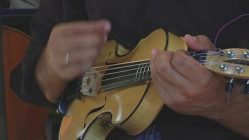
On the congress of the French violin making association ALADFI in 2008, I assisted a conference by Japanese scientist Eiichi Obataya concerning the influences of aging and chemical treatment on resonance wood. Besides the conclusion (which I personally find very assuring) that neither age nor man are capable of improving this fabolous natural matter, this conference discussed the possibilities of altering the least possible the properties of resonance wood by surface treatment.
The solution Mr Obataya proposed is lightyears from traditional violin making – the only examined substance which had acoustical properties pretty much the same as resonance wood was Urushi, a Japanese lacquer which is opaque, hard and rather thick. It can be found i.e. on traditional Japanes table art. Another use: Applied in several layers to paper or fabric, it was used to create the scles of the Samuraï armors !
The varnishes traditionally used in violin making (varnish based on natural rosin, dissolved in fat oils, essential oils or alcohol), althogh being thin and soupple, all damp the vibrations of the resonance wood. On classical violins, this damping certainly contributes to the characteristic sound colour.
As the Neolin is meant to have a different sound colour compared to the classical violin, the idea to try out a varnish with the same properties as the resonance wood was more than tempting !
Pure Urushi is a rosin coming out from a tree native to eastern Asia – this rosin is just filtered, no need of any solvant ! It polimerizes (dries, hardens) in humid air arout 75%. Once dry it becomes virtually indestructible: It’s very resistant to physical wear and damage, and totally resistant to heat, cold, acid, alcohol or any other solvant. Perfect to protect an instrument played on a rock stage !
Big disadvantage: Unless having dried completely, raw Urushi is causing violent skin allergies to appr. 80 % of all people. Well I’m lucky, I belong to the 20 other % !
Urushi does come in transparent with a golden brown colour, wiped off, as an extremely thin coating. I did not manage yet to find a filler which completely keeps it from getting into the wood pores. Urushi darkens when drying and thus gives ugly stains in the wood. Applied with a brush, Urushi exists in red and black, colored with pigments. It’s possible to make instrument in these two colours, or in both, as the Neolin on the picture. The finish can be mat, satined or brilliant (a brilliant finish is lots of work !)
Concerning sound, the result is very interesting ! Compared to the standard Neolin, the sound seems to have more high overtones. It looses some of its grain to become clearer. Soon I’ll be able to tell you what exactly happens to the sound on the page “Neolin / Sound analysis”.














Add comment